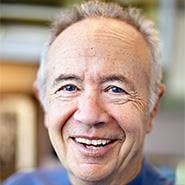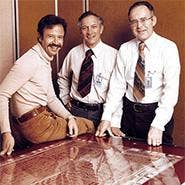Partners: Andy Grove Left Long-Lasting Impact On Silicon Valley And IT

Andy Grove, who may have done more than any other person to develop Silicon Valley as the center of the global IT industry, according to some solution providers, passed away Monday at the age of 79.
Grove was the third Intel employee and eventually rose to the roles of president, CEO, and chairman of the microprocessor powerhouse. No cause of death was listed.
Grove was born Andras Grof in Hungary in 1936, and survived both the Nazi occupation of Hungary and the Holocaust of World War II, as well as the post-war Soviet occupation of the country. He left Hungary in 1956, and arrived in the U.S. a year later, then changed his name to Andrew Grove.
[Related: Where Are They Now?: 1997 Industry Hall Of Fame Inductees]
After earning a Ph.D. in Chemistry from the University of California, Berkeley, he joined Fairchild Semiconductor, where he worked with Robert Noyce and Gordon Moore. Grove joined both after they left Fairchild to launch Intel, although he was not considered a co-founder of the company.
Decades later, he would leave an indelible mark on the IT industry and helped elevate Intel into one of the world's most recognized brands, solution providers told CRN.
As director of engineering, Grove led Intel's transformation from a focus on memory chips to the new world of microprocessors during the mid-1980s, when DRAM manufacturers faced falling demand and the dumping of chips on the market by Japanese manufacturers. Grove later led negotiations with IBM that resulted in IBM using Intel microprocessors for its then-new personal computer business.
Grove became Intel president in 1979, and chairman in 1987. Ten years later, he also became CEO, but dropped that title in 1998. He retired as chairman in 2004, but remained a senior advisor to the company for several years afterwards.
Grove's leadership of Intel was controversial at times. For instance, in 1994, a few missing entries in Intel's lookup table for its divide operation algorithm led to an error in the P5 Pentium's floating point unit, producing inaccurate results in approximately one in every 9 billion floating point divides. Intel called it a "slight reduction in precision," and tried to downplay its significance.
Later, Intel offered to replace processors, but only for those Pentium users who could prove that their systems had been affected by the flaw. That caused a public outcry, forcing Intel to offer to replace all flawed Pentium processors on request and cover the costs associated with the replacement program. That later led Intel to quickly report issues going forward.
Grove was instrumental in building Silicon Valley as the cradle of the IT industry and inspiring future generations of IT developers, according to many solution providers who worked with Intel over the years.
Grove's legacy is his dedication, spirit and passion for the industry, said Charles Liang, CEO president, and chairman of Super Micro Computer, a San Jose, Calif.-based system builder and motherboard manufacturer.

Grove grew Intel from a small chipmaker to a $30 billion giant, Liang told CRN. "His dedication inspired his employees, and his channel partners, and taught us how to be dedicated to growth," he said.
Liang said Grove was key to transforming Intel from a memory maker to focusing on manufacturing microprocessors. "At the time, there were a lot of microprocessor companies," he said. "Andy led Intel to a 90-percent market share. He made a great contribution to Silicon Valley and to the rest of the world."
Liang met Grove only once, after Supermicro showed Intel a particularly innovative motherboard design. "He was excited," he said. "He sent me a copy of his book, 'Only The Paranoid Survive.' I agree with his philosophy."
Dominic Daninger, vice president of engineering at Nor-Tech, a Burnsville, Minn.-based custom system builder, told CRN he still remembers the first time he read that book.
"Obviously, his youth growing up in Communist-occupied Hungary had a big impact on him," Daninger said. "That book was a guideline for me in my career. I have been a big believer in challenging new markets. It beats the heck out of getting run over by the competition. One of my early managers told me that Andy viewed the competition like he viewed Soviet tanks coming down the road."
Daninger, who worked with an early Intel processor, the 4004, to develop a system to control the entire sewer system for a city in the Minneapolis-St. Paul area, said Grove was instrumental in getting Intel into the processor business.
"At one time, Intel was going broke on its memory business," he said. "And Grove's getting IBM to base the PC on Intel and not on Motorola or something else was a huge move."
Eugene Kiang, president and CEO of Bold Data Technology, a Fremont, Calif.-based custom system builder, called Grove an IT industry icon.
"What can I say?" Kiang told CRN. "He was a pioneer in Silicon Valley, and one of the guys that put Silicon Valley on the map."
Grove was behind the "Intel Inside" program that made Intel a worldwide brand, starting with the iconic five-note tune that still accompanies Intel advertisements, Kiang said. "The Intel Inside campaign was huge in the '90s," he said. "It made Intel a worldwide company."
Kiang also said Grove showed how a strong work ethic could pay off. "He took a small chip maker to worldwide dominance," he said. "Before Apple, Intel was the second-most-recognized brand in the world, after Coca-Cola."
Another system builder executive, who preferred to remain anonymous due to corporate policies, said the IT industry and channel will remember Grove's impact, including his innovations in the channel.
"He will be missed," the solution provider told CRN. "The products and technologies he introduced to the market were a big influence, and will be around for a long while."
A lot of younger people in the IT industry may not know Grove's name, Daninger said. "But today, they are standing on the shoulder of a real giant," he said.